We've independently reviewed this article to make sure it's as accurate as we can make it.
To find out more about our article creation and review process, check out our editorial guidelines.
Are you tired of dealing with a washer that smells of mold and must?
You’re not alone! I know how frustrating it can be, especially when you have a huge pile of dirty clothes to wash.
Luckily, you’ve come to the right place!
To clean a washer with a moldy or musty smell, you’ll need to run a cleaning cycle with vinegar, scrub the drum, clean the detergent dispenser, and inspect the seals. Cleaning the drain pump or valve filters and leaving the door open after each cycle is also important.
Read on for a detailed guide to help you banish that moldy, musty smell from your laundry room once and for all.
How to Clean A Washer That Smells of Mold or Must: 10 Steps
Unfortunately, it’s very common for washers to have a musty or moldy smell. But don’t worry! Solving the problem is very simple.
Here’s all the materials you’ll need to clean your moldy washer:
- White vinegar or commercial cleaning tablets.
- Baking soda.
- A scrub brush.
- Clean rags.
- A bucket or container.
- A flashlight or good lighting source.
- Rubber gloves (optional).
Are you ready to clean your washing machine? Let’s dive in!
#1 Identify the Source of the Musty Smell
First, you must determine where the musty or moldy smell comes from.
In my experience, unpleasant odors in a washer can be due to detergent residue, fabric softener buildup, mold or mildew, and lingering moisture.

Please keep your eyes (and nose) peeled as we go through the following steps to pinpoint the source and tackle it head-on.
#2 Run a Cleaning Cycle with Vinegar or Bleach
To eliminate the smell of mold or must from your washer, it’s important to run a cleaning cycle with white vinegar.
First, fill your washer with hot water and add two cups of white vinegar. Then, run a full cycle on the highest heat setting.
Vinegar’s acidity will help break down detergent residue, soap scum, and mineral deposits contributing to the moldy and musty smell.
Check the owner/user manual to learn how to use the cleaning feature.
You can also use cleaning tablets to deodorize your washer. Just ensure they are compatible with your machine and follow the instructions provided on the packaging.
In my opinion, the Affresh tablets are great at eliminating musty and moldy smells!
#3 Scrub the Drum with Baking Soda
The next step in cleaning a washer that smells of mold or must is to use baking soda.
Baking soda is my go-to when cleaning washers, as it can absorb and remove any lingering odor and further clean the drum.
After the vinegar cycle, sprinkle half a cup of baking soda inside the drum. Then, using a scrub brush, give the drum a thorough scrubbing, making sure to reach all those nooks and crannies.
Remember, it’s not a race – take your time to ensure you’ve covered every inch of the drum.
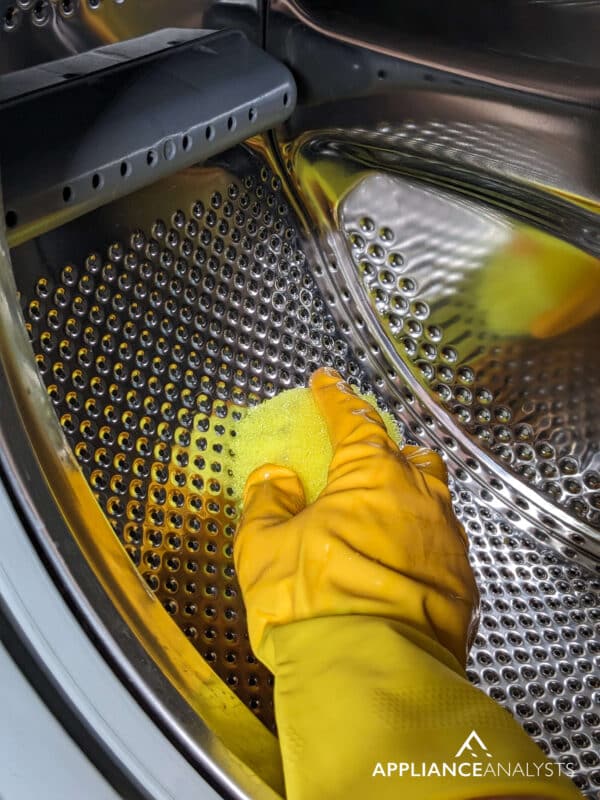
#4 Clean the Detergent Dispenser
When removing mold from a washer, I always advise homeowners to inspect the detergent dispenser.
You see, the detergent dispenser can be a breeding ground for mold and mildew, so it’s essential to clean it well.
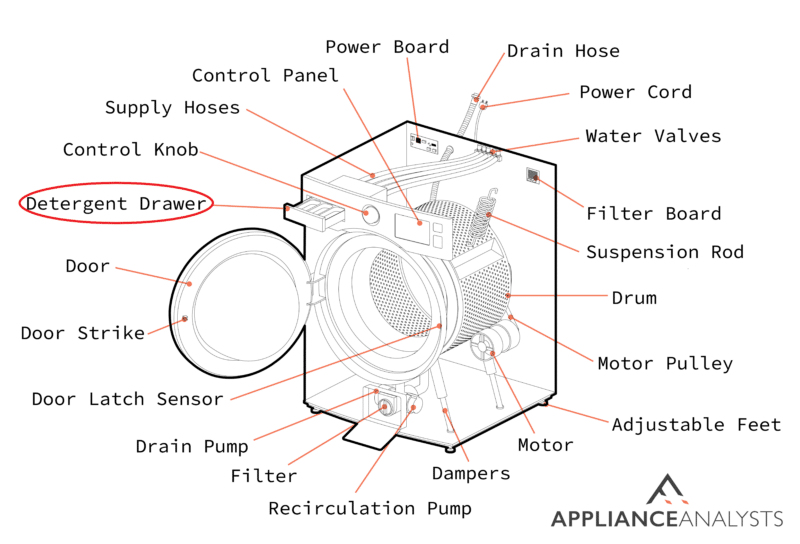
First, remove the dispenser drawer (usually at the top or front of the machine) and soak it in hot water and white vinegar for about 15 minutes. While it’s soaking, use a scrub brush to clean the area where the dispenser drawer sits.
Remember to scrub those hard-to-reach areas. After cleaning, replace the dispenser drawer and run a rinse cycle to flush out any remaining residue.
#5 Inspect and Clean the Door Seal (Font-Load Washers)
From what I’ve seen, front-loading washers are notorious for harboring mold and mildew in their door seals.
So, if you have a front-load washer, please inspect the seal by opening the door and locating the rubber gasket (or seal) that runs along the perimeter of the opening.
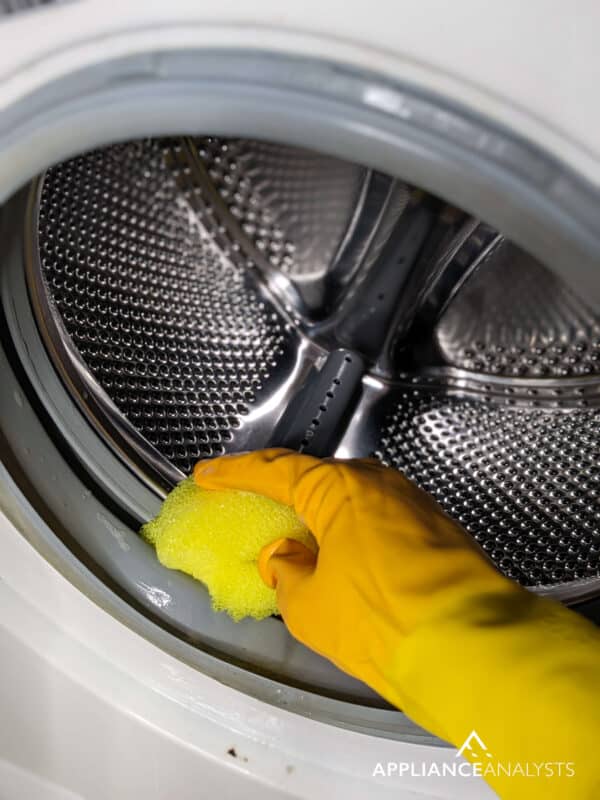
The gasket should be flexible and slightly wrinkled, like the neck of a well-loved turtleneck sweater. Next, peel back the seal folds and look for signs of mold or mildew. If you spot any, it’s time for some serious scrubbing.
Mix equal parts of white vinegar and water in a bucket, then dip a clean rag or scrub brush into the solution.
Vigorously scrub the affected areas until the mold or mildew is gone. Once satisfied, wipe the area with a clean, damp cloth to remove any remaining vinegar solution.
#6 Inspect and Clean the Lid Seal (Top-Load Washers)
For top-load washers, checking the lid seal for mold and mildew is essential.
The seal is typically a soft, flexible strip of rubber or plastic that runs along the edge of the lid, creating a watertight seal when the lid is closed.
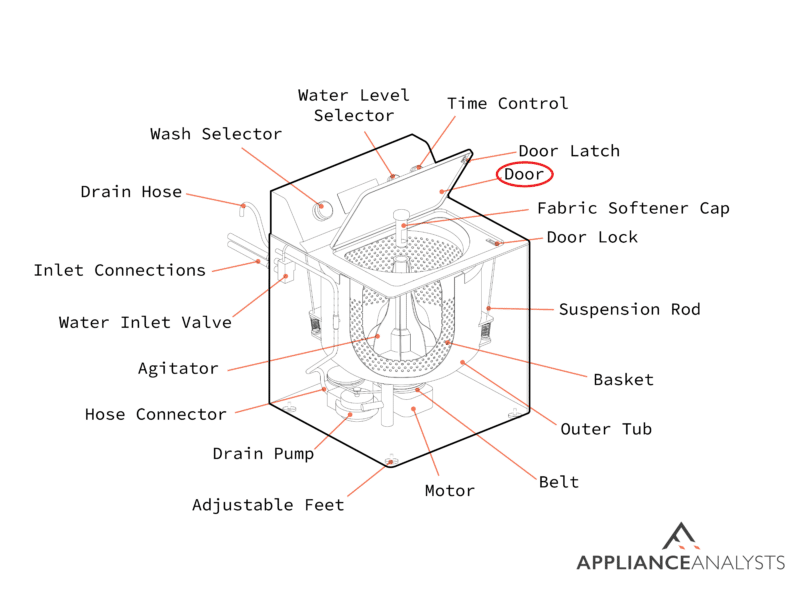
Closely inspect the seal with a flashlight or good lighting for any signs of mold or mildew. If you find any, it’s time to get scrubbing.
Using the same white vinegar and water solution from Step 5, dip a clean rag or scrub brush into the mixture and scrub the affected areas until the mold or mildew is gone.
After you’ve finished, wipe the area with a clean, damp cloth to remove any remaining vinegar solution.
#7 Check the Door Latch or Lid Lock
The next step in cleaning a washer that smells of mold or must is to inspect the door latch.
The door latch (for front-loaders) or lid lock (for top-loaders) is the mechanism that keeps your washer door or lids securely closed during a cycle. It’s on the edge of the door or the front of the machine, opposite the hinges, or on the top edge of the lid.
In my experience, if the door latch or lid lock is covered in mold or mildew, it can contribute to the moldy or musty smell. Please thoroughly clean it with vinegar and water solution, using a clean rag or an old toothbrush to get into any small crevices.
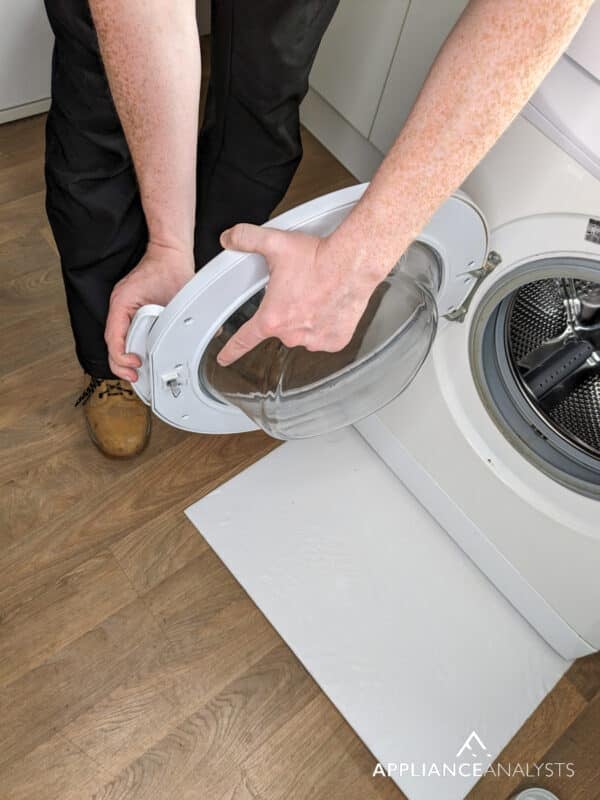
#8 Clean the Drain Pump or Valve Filters
If you’ve tried the steps above, but your washer still smells of mold or must, you’ll need to inspect the drain pump or valve filters.
Many front-load washers have a drain pump filter designed to catch lint, coins, and other debris that could clog the drain. If the filter becomes clogged or moldy, it can contribute to unpleasant odors.
To access the filter, consult your tech service manual, as the location can vary from model to model. In many cases, it’s behind a small panel near the bottom of the machine or underneath the drum.
Once you’ve located the filter, remove it and inspect it for any signs of mold or mildew. Then, I recommend cleaning the filter with a mixture of white vinegar and water and scrubbing away any debris or buildup. After cleaning, reinstall the filter and make sure it’s securely in place.
While you’re at it, please locate the drain hose, which is typically near the removable filter, and pull it out. Then, place it inside a bucket and allow the water to drain out completely Try draining your front-load washer at least once a month.
For top-load washers, filters are typically found on the valves. The valve filters sift the water going in and out of the pump and hoses. If your top-load washer has removable filters, consult the tech manual on properly removing them.
#9 Leave the Door or Lid Open Between Loads
My usual advice for preventing a moldy or musty smell in a washer is to leave the door or lid open between loads.
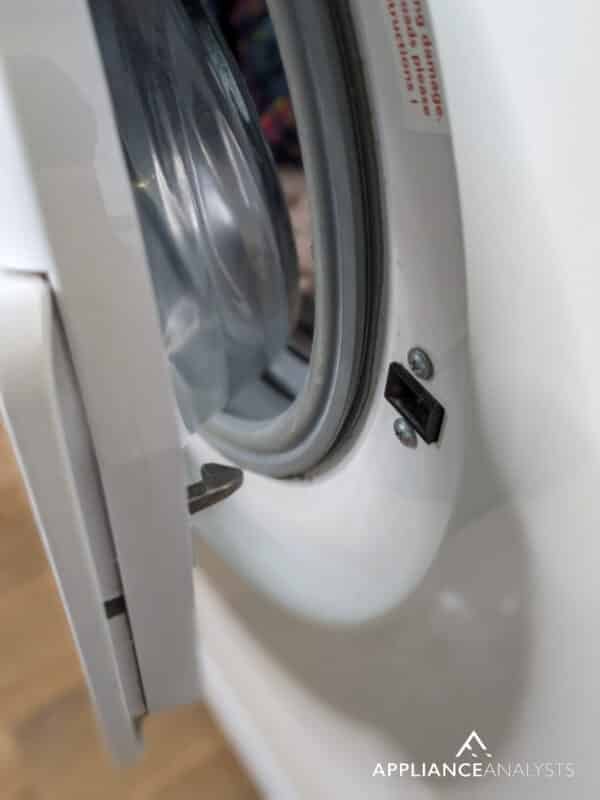
By leaving the door open, you’ll allow air to circulate inside the drum, helping to dry out any lingering moisture that could encourage mold and mildew growth.
If you’re concerned about curious pets or children, consider using a laundry room door or baby gate to keep them out of the area while the washer is airing out.
#10 Run Regular Maintenance Cycles
Finally, make a habit of running regular maintenance cycles to keep your washer from developing a musty or moldy smell.
At least once a month, run a cleaning cycle with white vinegar or a store-bought washing machine cleaner. It will help break down any lingering residue, prevent mold and mildew growth, and keep your washer running smoothly.
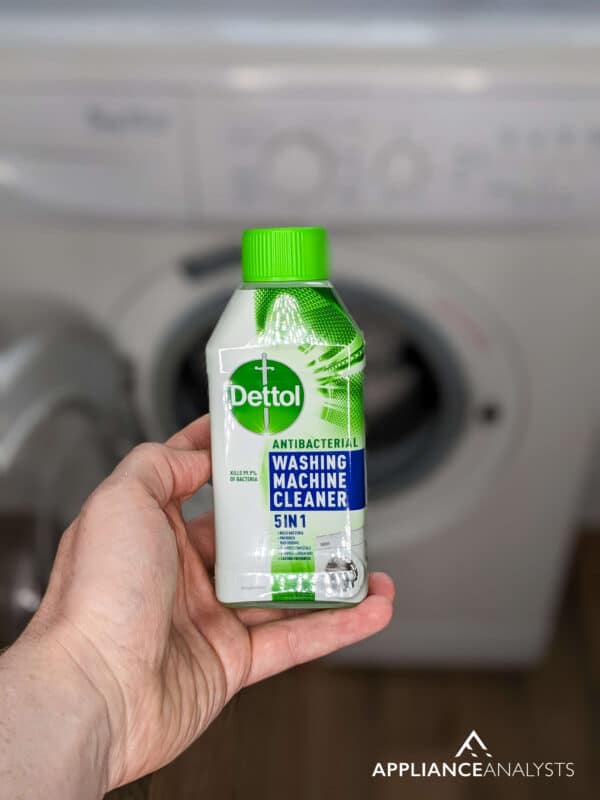
Keep in mind that if the musty smell persists despite trying all the steps mentioned earlier, it can be a sign of mildew buildup between the plastic tub that holds the water and the metal tub responsible for agitation. In such cases, I recommend increasing the frequency of your cleaning cycles, possibly to once a week.
Alternatively, you could consider calling an appliance repair expert to disassemble your washer. However, it’s worth noting that this is a complex and expensive repair, costing up to $1100!
Conclusion
Hopefully, now you know how to clean a washer that smells of mold or must.
Remember, to eliminate the musty or moldy smell, you’ll need to run a cleaning cycle with vinegar, scrub the drum with baking soda, clean the detergent dispenser, inspect the seals, and clean the door latch.
Don’t forget to leave the door or lid open after each cycle to prevent mold growth.
Thank you so much for reading! If you found this guide helpful, please check out our other related articles below.
Good luck!








